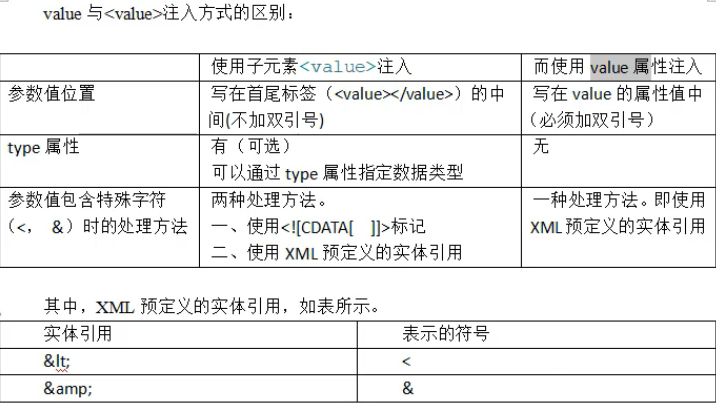Spring 依赖注入(DI) 的三种方式 和 对集合类型的注入
// 分别省略了getter setter public class Student { private String name; private int age; private Teacher teacher; } public class Teacher { private String tno; private String name; }
<bean id="teacher" class="com.DO.Teacher"> <property name="tno" value="123"></property> <property name="name" value="ls"></property> </bean>
1、set方式注入(利用反射):
<bean id="student" class="com.DO.Student"> //调用类的无参构造器 <property name="name" value="zxf"></property> // 调用对应属性的set方法 <!-- <null/> 给属性赋 null <property name="name"> <null/> </property> --> <property name="age"> <value>22</value> </property> <property name="teacher" ref="teacher"></property> </bean>
注意:

2、通过构造器注入:
<bean id="student" class="com.DO.Student"> <!-- 根据参数的个数 会去调用相应的构造器 也可以通过索引指定 index 从0开始 也可以通过name指定参数名 或者指定参数的类型type --> <constructor-arg value="zs"></constructor-arg> <constructor-arg value="23"></constructor-arg> <constructor-arg ref="teacher"></constructor-arg> </bean>
3、p命名空间:
引入p命名空间:
xmlns:p="http://www.springframework.org/schema/p"
<bean id="student" class="com.DO.Student" p:name="zs" p:age="22" p:teacher-ref="teacher"></bean>
自动装配:

byName:属性 与 bean的id 相同就自动装配
byType:属性 与 bean的类型(class="") 相同就自动装配
可以把所有的bean都设置成自动装配: 在命名空间里添加: default-autowire="defalut"
自动装配会减少代码量,但是胡降低可读性
<bean id="student" class="com.zxf.DO.Student" autowire="byName"> <property name="name" value="zs"></property> <property name="age" value="22"></property> <!-- 自动装配: 如果 该bean的属性 与 某个bean的id相同就会自动装配 student的teacher属性 与 id="teacher" 相匹配 byName 的本质是 byId --> </bean>
SpringIOC容器负责创建Bean
依赖注入:set方式注入: 把属性值注入给属性,把属性注入给对象。
通过构造器注入:调用相应的构造器,然后把value值注入进去。
p命名空间: 即使用p命名空间注入属性值。
控制反转:反转了用户获取对象的方式,从new (创建) --> get(直接拿)
对集合类型的注入:
// 省略了对应的getter setter public class ALLCollection { private List listElement; private String[] arrayElement; private Set setElement; private Map mapElement; private Properties propsElement; }
<bean id="collection" class="com.zxf.DO.ALLCollection"> <property name="listElement"> <list> <value>list苹果</value> <value>list香蕉</value> </list> </property> <property name="arrayElement"> <array> <value>array苹果</value> <value>array香蕉</value> </array> </property> <property name="setElement"> <set> <value>set苹果</value> <value>set香蕉</value> </set> </property> <property name="mapElement"> <map> <entry> <key><value>map1</value></key> <value>map苹果</value> </entry> <entry> <key><value>map2</value></key> <value>map香蕉</value> </entry> </map> </property> <property name="propsElement"> <props> <prop key="prop1">prop苹果</prop> <prop key="porp2">prop香蕉</prop> </props> </property> </bean>


 浙公网安备 33010602011771号
浙公网安备 33010602011771号